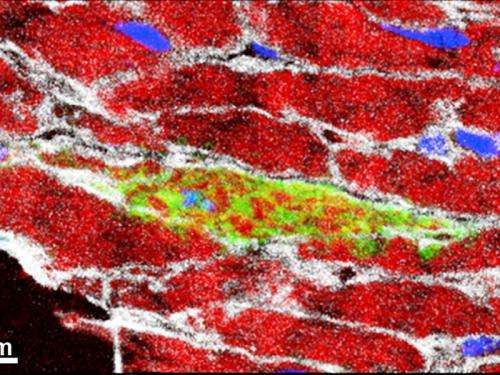The heart's own stem cells play their part in regeneration

(Medical Xpress)—Up until a few years ago, the common school of thought held that the mammalian heart had very little regenerative capacity. However, scientists now know that heart muscle cells constantly regenerate, albeit at a very low rate. Researchers at the Max Planck Institute for Heart and Lung Research in Bad Nauheim, have identified a stem cell population responsible for this regeneration. Hopes are growing that it will be possible in future to stimulate the self-healing powers of patients with diseases and disorders of the heart muscle, and thus develop new potential treatments.
Some vertebrates seem to have found the fountain of youth, the source of eternal youth, at least when it comes to their heart. In many amphibians and fish, for example, this important organ has a marked capacity for regeneration and self-healing. Some species in the two animal groups have even perfected this capability and can completely repair damage caused to heart tissue, thus maintaining the organ's full functionality.
The situation is different for mammals, whose hearts have a very low regenerative capacity. According to the common school of thought that has prevailed until recently, the reason for this deficit is that the heart muscle cells in mammals cease dividing shortly after birth. It was also assumed that the mammalian heart did not have any stem cells that could be used to form new heart muscle cells. On the contrary: new studies show that aged muscle cells are also replaced in mammalian hearts. Experts estimate, however, that between just one and four percent of heart muscle cells are replaced every year.
Scientists in Thomas Braun's Research Group at the Max Planck Institute for Heart and Lung Research have succeeded in identifying a stem cell population in mice that plays a key role in this regeneration of heart muscle cells. Experiments conducted by the researchers in Bad Nauheim on genetically modified mice show that the Sca1 stem cells in a healthy heart are involved in the ongoing replacement of heart muscle cells. The Sca-1 cells increase their activity if the heart is damaged, with the result that significantly more new heart muscle cells are formed.
Since, in comparison to the large amount of heart muscle cells, Sca-1 stem cells account for just a tiny proportion of the cells in the heart muscle, searching for them is like searching for a needle in a haystack. "We also faced the problem that Sca-1 is no longer available in the cells as a marker protein for stem cells after they have been changed into heart muscle cells. To prove this, we had to be inventive," says project leader Shizuka Uchida. The Max Planck researchers genetically modified the stem cells to such an extent that, in addition to the Sca-1, they produced another visible marker. Even if Sca-1 was subsequently no longer visible, the marker could still be detected permanently.
"In this way, we were able to establish that the proportion of heart muscle cells originating from Sca-1 stem cells increased continuously in healthy mice. Around five percent of the heart muscle cells regenerated themselves within 18 months," says Uchida. Moreover, mice suffering from heart disease triggered by the experiment had up to three times more of these newly formed heart muscle cells.
"The data shows that, in principle, the mammalian heart is able to trigger regeneration and renewal processes. Under normal circumstances, however, these processes are not enough to ultimately repair cardiac damage," says Braun. The aim is to find ways in which the formation of new heart muscle cells from heart stem cells can be improved and thereby strengthen the heart's self-healing powers.
More information: Shizuka Uchida,Piera De Gaspari, Sawa Kostin, Katharina Jenniches, Ayse Kilic,Yasuhiro Izumiya, Ichiro Shiojima, Karsten grosse Kreymborg, Harald Renz, Kenneth Walsh, and Thomas Braun, Sca1-derived cells are a source of myocardial renewal in the murine adult heart. Stem Cell Reports, Volume 1, Issue 5, 19 November 2013, Pages 397–410


















